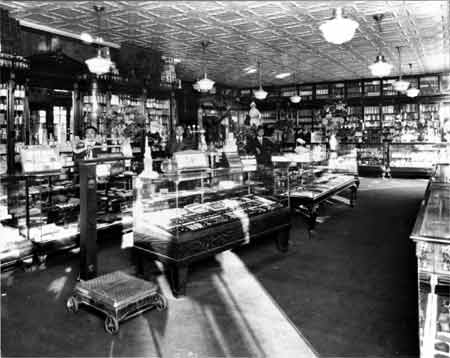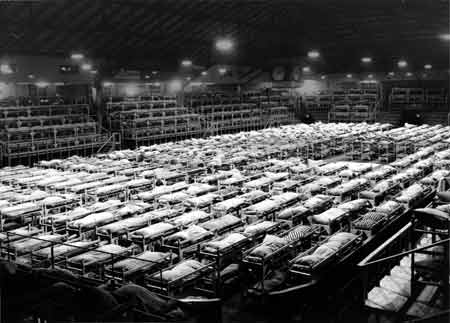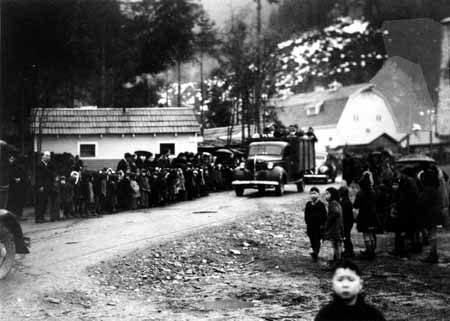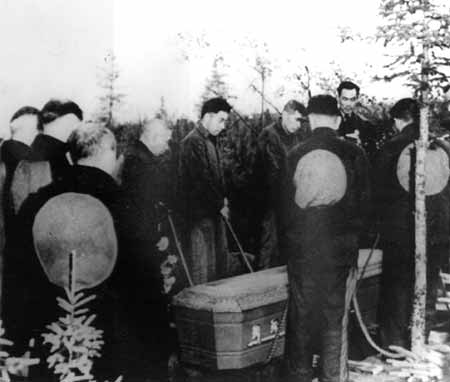Artifact 1 |
Japanese Canadian home on Powell Street in Vancouver (pre - 1941)
Powell Street was the largest Japanese Canadian community in Canada before the mass uprooting in 1942. Institutions such as the Japanese newspaper, Japanese language school, and churches were well established. Consider the following questions as you examine this photograph:
|
Artifact 2
|
Japanese Canadian Jewelry Store in the Vancouver pre-war community.
An example of one type of business later lost in the mass uprooting. Photo: UBC Consider the following questions as you examine this photograph:
|
Artifact 3
|
Official Registration Cards (1940-1941)
In Spring 1941, before Pearl Harbor and Canada's declaration of war with Japan, the Royal Canadian Mounted Police finger-printed and registered all Japanese Canadians over the age of 16. They were required to carry identification cards until 1949. Consider the following questions as you examine this photograph:
|
Artifact 4 - Newspaper Articles
|
B.C. Government Refuses To Pay Cost Of Educating
All Japanese Students To Go Before City School OpenSpokesmen for the B.C. Securities Commission today declared all Japanese children may be moved out of the city by the time school opens or within a very short time after September 1. They point out that even though a small group of Japanese are left in the city when the fall term opens, it would be impractical to send them to school for a few weeks or months while preparations are being made to move them. Last year 2300 Japanese youngsters attended city schools. Removing them from school registration will mean a reduction in the number of teachers needed of "at least 60 and probably more," declares O.J. Thomas, school inspector. The greatest challenge will be felt at Strathcona School which has had a Japanese attendance of more than 600 for several years. At least eight fewer teachers will be needed at the school this coming term. Many senior students have entered war work during the summer and will not return to school, bringing a further sharp decrease in school enrolment, Mr. Thomas pointed out. NO REPLACEMENTS. A large number of school teachers have also gone to war industries and the armed services but due to the absence of Japanese at schools and the many white senior students who will remain in war work, it is unlikely the board will hire replacement teachers. Numbers of new teachers are available to the Vancouver School Board this year but the situation is reversed in practically every rural district. In the country areas teachers who receive less money than city teachers, are entering war industries and the armed forces faster than they can be replaced Say Ottawa's Responsibility By Daily Province Staff Correspondent VICTORIA, Aug. 19 - Efforts by the B.C. Security Commission to place upon the British Columbia Government the cost of educating Japanese children under control of the commission have been flatly refused, Hon. H.G. Perry, minister of education, announced this morning. The commission, which is charged with the care of all Japanese, sought to have the Provincial Government provide schools, teachers, supervisors and Japanese coaches for 5500 children, of whom 1000 are of school age. The total cost would be $345,000. The plan would mean the construction of additional school accommodation at interior points where Japanese have been located. The commission asked for white teachers. This was flatly refused, on the ground that with schools having to be closed throughout the province for want of qualified teachers, that the department of education was not going to create a further drain for the purpose of providing teachers for Japanese children. BAR SUPERVISOR PLAN. The commission, as an alternative plan, suggested the department of education provide 13 white supervisors and engage 113 Japanese teachers, or coaches. This was refused. The position assumed by Mr. Perry, who is backed by the entire cabinet, is that the education problem for Japanese was created by the Dominion and not the Provincial Government. It was the Dominion, through the B.C. Security Commission, that moved the Nipponese as a war security measure. SYSTEM AMPLE BEFORE. Mr. Perry pointed out in a letter to the commission that British Columbia's school system was ample to take care of Japanese as well as white children before the movement to the interior was started. The government does not feel that is should be called on to enlarge its school system for the accommodation of wards of the Dominion. In fact the executive council backs Mr. Perry in:
In the building at 439 Alexander that once housed the Japanese Language School, Canadian troopers are learning to fight and kill the sons of Nippon. Headquarters of the Six Field Company, R.C.E. (Reserve) was moved from the old Y.M.C.A. building into the east end premises this week and on training nights the men of the Reserve Engineering force are being taught to build bridges and blow them up. The school, vacated with the evacuation of Japanese from coastal areas, was a centre of Oriental culture before the war. Young Jap children were taught the language and customs of their parents' homeland in late afternoon classes that followed attendance at city public schools. Education of Japanese Canadian students in question (Sept. 1942) "When we Japanese Canadian pupils got to Strathcona school, we were told in groups or individually by Mr. Glass, the vice-principal, that we could not come to school anymore. Because Canada was at war with Japan. Instead, he said, we were only allowed to collect our personal items from our former classrooms. So I went into the Grade 7 classroom and got my belongings, which I had left there in June. I will never forget the sad expression on the face of Miss Bolton, my Grade 7 teacher, as she said goodbye, shaking her head." - Shogo Kobayashi, pg. 1, Teaching in Canadian Exile. |
Consider the following questions as you read this news article:
|
Artifact 5 - Official Notice
|
Order In Council Notice:
NOTICETO ALL PERSONS OF JAPANESE RACIAL ORIGINHaving reference to the Protected Area of British Columbia as described in an Extra of the Canada Gazette, No. 174 dated Ottawa, Monday, February 2, 1942:
Louis S. St. Laurent Minister of JusticeTo Be Posted in a Conspicuous Place- End of Order In Council Notice - Notice To All Persons of Japanese Racial Origin (Feb. 26, 1942) The Order in Council PC 1486, passed on February 23, 1942 authorized the removal of all "persons of Japanese racial origin" and gave the RCMP the power to search without warrant, enforce a dusk-to-dawn curfew, and to confiscate cars, cameras, radios, and firearms. |
Consider the following questions as you read over this document:
|
Artifact 6
|
Hastings Park Detention Centre (1942)
For Japanese Canadians from outlying areas the first stop on the road to exile was Hastings Park. Women and children were assigned to the livestock building. Men were housed in the Forum. Conditions were barbaric - privacy was non-existent; the latrines were open gutters; the food unpalatable. Outbreaks of diarrhea added to the misery. Many were confined there for months without knowing where they would be sent or what had become of their husbands, families and relatives. Consider the following questions as you examine this photograph:
|
Artifact 7
|
Arriving in Tashme (March 1942)
Trains and trucks were used to forcibly remove the 22,000 Japanese Canadians from the 100 mile "protected area" of the west coast of British Columbia in the spring, summer and fall of 1942. The family camps were located in mining ghost towns or were created on leased farmland or ranchland in the interior of British Columbia. Consider the following questions as you examine this photograph:
|
Artifact 8
|
A Death of a Fellow Inmate - Prisoner of War Camp - Angler, Ontario (1942)
Issei and Nisei internees at Angler were treated as enemy prisoners-of-war with a line up for roll call each morning. The large circle on their backs made a perfect target should they try to escape. The 766 inmates ranged in age from 17 to 60. The majority were Nisei from the Mass Evacuation Group who protested the splitting up of families and demanded removal in family units. Consider the following questions as you examine this photograph:
|
Artifact 9 - Notice
|
BC Security Commission Notice:
Vancouver, B.C. May 19, 1942.IMPORTANT NOTICE(This notice cancels the "White" notice issued May 12, 1942) Listed below are general instructions respecting baggage and food to be taken to the Projects as shown, and deals only, with information pertaining to groups leaving Vancouver area to Commission Projects. INTERIOR HOUSING PROJECTS:
Additional Baggage over the weight allowed can be stored in Vancouver and forwarded by freight at the owner's risk and expense when required, and when room at the Project is available. J. SHIRRAS, Commissioner British Columbia Security Commission- End of Security Commission Notice - Transportation of luggage/baggage to work camps, housing projects and sugar beet projects. (May 1942) The BC Security Commission devised three major destinations for the dispersal of the Japanese Canadians:
|
Consider the following questions as you read over this document:
|
Artifact10
|
Letter to Office of the Custodian:
Kaslo, B.C. September 21st, 1944. Office of the Custodian, Department of the Secretary of State, Royal Bank Building, Vancouver, B.C. Dear Sirs: I have recently been advised that you sold my farmland which is known and descrived as S1/4 of NW1/4 of Sec. 32, T.P.2, District of New Westminster and located in the Municipality of Surrey, to the Director of the Veterans' Land Act. I should like to point out to you that the alleged transfer of this property was made without any consultation to me and without my consent. I do object to your action and I hereby protest for this forced sale of my property. I am an ex-service man having served in the Canadian Expeditionary Forces in the last Great War, and this farmland was acquired by me through the Solier Settlement Board for the price of $3200 in 1919. Since I bought this wild land, 32 acres were cleared by me out of which 20 acres are undercultivation and productive, and also since then two dwellings, two roots houses, a barn and a woodened were built, thus the value of the property was estimated to be approximately $14000.00. I can not but think that you are wrongfully exercising your capacity in selling property of an exservice man for the purpose of reselling the same to an ex-service man of the present war. Hoping this will draw your special attention, I am, Yours truly, Z. Inouye - End of Letter - Letter to the Office of the Custodian of Enemy Alien Property (Sept. 1944) The Order in Council PC 1665 (Spring 1942) entrusted to the Custodian of Enemy Alien Property all the belongings of Japanese Canadians as a "protective measure only". PC 5523 (June 1942) The Director of Soldier Settlement is given authority to purchase or lease farms owned by Japanese Canadians. January 1943, the Custodian of Enemy Alien Property is granted the right to dispose of Japanese Canadian properties in his care without the owners' consent. |
Consider the following questions as you read this letter:
|
Artifact 11
|
Slocan City train station (Spring 1946)
Canadian-born children Yukiko and Sakon (Don) Sato were exiled to Japan. Dan was born in Slocan 2 years earlier. He remained in Japan until 1960. Before the deportation orders were cancelled in Jan. 1947, 4,000 Japanese Canadians had already been "repatriated". Photo: JC Centennial Project and JCCA Collection. Consider the following questions as you examine this photograph:
|
Artifact 12
|
Government Notice:
DEPARTMENT OF LABOUR CANADA NOTICETo All Persons of Japanese Racial Origin Now Resident in British Columbia
Commissioner of Japanese PlacementVancouver, B.C. March 12th, 1945 - End of Notice - Notice of Dispersal and "Repatriation" to Japan (Mar. 1945) |
The war with Japan was all but over and as Japanese Americans were returning to their homes and businesses which were not confiscated and liquidated, Japanese Canadians were having to demonstrate their loyalty by dispersing east of the Rockies, or face "repatriation" to Japan.
Consider the following questions as you read through this document:
|






